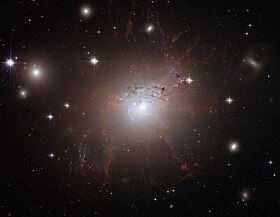NGC 1275
外观
| NGC 1275 | |
|---|---|
 哈伯太空望远镜的NGC 1275影像 | |
| 观测资料(J2000 历元) | |
| 星座 | 英仙座 |
| 赤经 | 03h 19m 48.1s[1] |
| 赤纬 | +41° 30′ 42″[1] |
| 红移 | 5264 ± 11公里/秒[1] |
| 距离 | 235 Mly |
| 视星等 (V) | 12.6[1] |
| 特征 | |
| 类型 | cD;pec;NLRG[1] |
| 角直径 (V) | 2′.2×1′.7[1] |
| 其他名称 | |
| Perseus A,[1] PGC 12429,[1] UGC 2669[1] | |
NGC 1275 (也称为英仙座A,科德韦尔24)是1.5型的西佛星系[2],位在英仙座的方向上,距离大约2亿3500万光年。NGC 1275对应于电波星系英仙座A,是位于巨大的英仙座星系团中心的星系。
动力学
[编辑]
NGC 1275包含2个星系,在英仙座星系团中央的CD星系,和躺在前方以3,000公里/秒朝向主体高度移动,并且相信应该与英仙座星系团合并的"高速系统"(HVS)[3]。HVS与CD星系的距离至少有20万光年,因此不受它的影响[4]。星系团中心的星系包含散发出纤维状谱线的大质量网络[5],看起来似乎会延迟相对论性等离子引发的气泡在中心的活跃星系核中的生成[6]。由气体组成长的气体丝成螺旋状的延伸至星系之外,进入数百万度高温,充满了星系团辐射出X射线的气体。在一条典型螺旋细丝上的气体包含的质量百万倍于我们的太阳,但宽度只有200光年,并且可以笔直的延伸达20,000光年[7]。
细丝的存在引发一个问题,因为它们的温度比星系团周围的云气低,它们是如何或许维持了一亿年之?它们为何不会变暖?消散或是塌缩成为恒星[8][9]?一个可能是有着微弱的磁场(大约地球磁场强度的万分之一)施加了足够的力量使离子在螺线上聚集[8][9]。
NGC 1275 含有130亿太阳质量的分子云。[10]
在NGC 1275的核心,据信是个3.4亿太阳质量的超大质量黑洞。[11]
外部链接
[编辑]- WikiSky上关于NGC 1275的内容:DSS2, SDSS, GALEX, IRAS, 氢α, X射线, 天文照片, 天图, 文章和图片
- NASA image & description(页面存档备份,存于互联网档案馆)
- Another NASA image, showing unusual gas filaments(页面存档备份,存于互联网档案馆)
- Fabian, A.C., et al. A deep Chandra observation of the Perseus cluster: shocks and ripples(页面存档备份,存于互联网档案馆). Monthly Notices of the Royal Astronomical Society. Vol. 344 (2003): L43(arXiv:astro-ph/0306036v2)。
- Fabian, A.C. Nature 454, 968-970(页面存档备份,存于互联网档案馆)
参考资料
[编辑]- ^ 1.0 1.1 1.2 1.3 1.4 1.5 1.6 1.7 1.8 NASA/IPAC Extragalactic Database. Results for NGC 3109. [2006-11-19]. (原始内容存档于2011-05-14).
- ^ Ho, Luis C.; Filippenko, Alex V.; Sargent, Wallace L. W., A Search for "Dwarf" Seyfert Nuclei. III. Spectroscopic Parameters and Properties of the Host Galaxies, Astrophysical Journal Supplement 112, October 1997, 112: 315–390 [2009-03-31], (原始内容存档于2016-01-10)
- ^ Minkowski R., 1957, in IAU Symp 4, Radio astronomy, p107
- ^ Gillmon K., Sanders J.S., Fabian A.C., An X-ray absorption analysis of the high-velocity system in NGC 1275 (页面存档备份,存于互联网档案馆), 2004, MNRAS, 348, 159
- ^ Lynds R., Improved Photographs of the NGC1275 Phenomenon, 1970, ApJ, 159, L151
- ^ Hatch N.A., Crawford C.S., Johnstone R.M., Fabian A.C.: On the origin and excitation of the extended nebula surrounding NGC1275 (页面存档备份,存于互联网档案馆), 2006, MNRAS, 367, 433
- ^ Hubble Sees Magnetic Monster in Erupting Galaxy (页面存档备份,存于互联网档案馆) Newswise, Retrieved on August 21, 2008.
- ^ 8.0 8.1 A. C. Fabian; et al. Magnetic support of the optical emission line filaments in NGC 1275. Nature. 2008-08-21, 454: 968–970 [2009-03-31]. (原始内容存档于2009-03-24).
- ^ 9.0 9.1 Chang, Kenneth. Hubble Images Solve Galactic Filament Mystery. The New York Times. 2008-08-21 [2009-03-31]. (原始内容存档于2011-06-01).
- ^
Lim, Jeremy; Ao, Yi Ping; Dinh‐v‐Trung, Dinh-V-Trung. Radially Inflowing Molecular Gas in NGC 1275 Deposited by an X-Ray Cooling Flow in the Perseus Cluster. The Astrophysical Journal. 2008, 672: 252–265. Bibcode:2008ApJ...672..252L. arXiv:0712.2979
 . doi:10.1086/523664.
. doi:10.1086/523664.
- ^
Wilman, R. J.; Edge, A. C.; Johnstone, R. M. The nature of the molecular gas system in the core of NGC 1275. Monthly Notices of the Royal Astronomical Society. 2005, 359 (2): 755–764. Bibcode:2005MNRAS.359..755W. arXiv:astro-ph/0502537
 . doi:10.1111/j.1365-2966.2005.08956.x.
. doi:10.1111/j.1365-2966.2005.08956.x.
